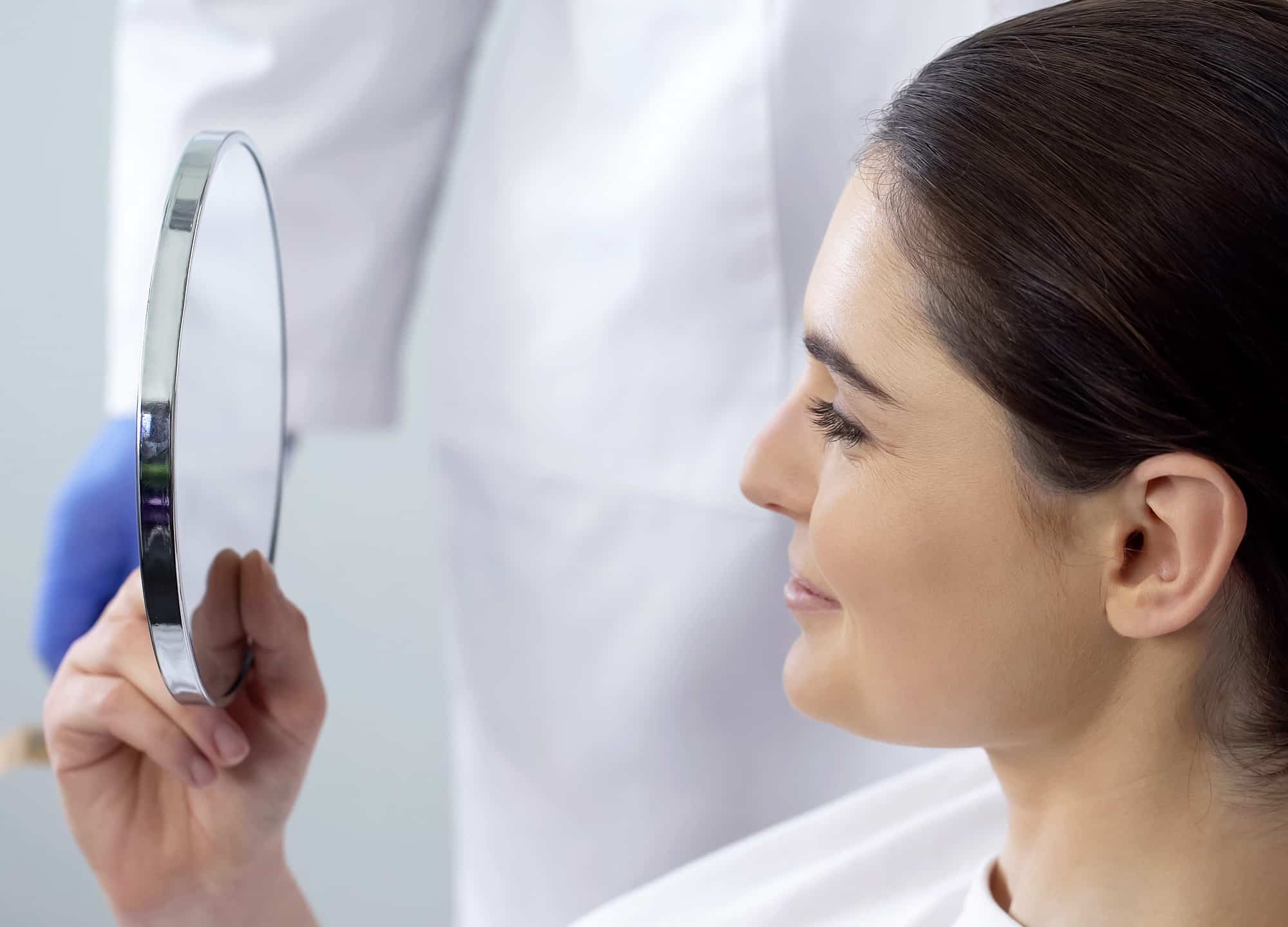Rhinoplasty is the third most common plastic surgery in the U.S., a statistic that leads many to believe it’s a straightforward procedure. For the most part, it is—but given that its 5–15% revision rate is actually quite high and teenagers make up 14% of the patients going in for the procedure, there are a few things those considering a nose reshaping should know before making their decision.
We asked RealSelf doctors and members of our community to share their expertise and insight into what getting rhinoplasty is really like.
1. There is no such thing as the perfect nose.
A successful rhinoplasty is designed to improve the look of your nose, not give you an entirely new one. “There is no such thing as a perfect nose,” says Dr. Elliot Heller, a New York City board-certified facial plastic surgeon. Surgery can change the shape and profile and address crookedness and drooping, but that doesn’t mean you’ll have total symmetry or an airbrushed celebrity nose right out of a magazine. Go in with reasonable expectations and find a doctor who will work to enhance your features, not give you different ones.
No doctor can guarantee exactly what your final result will look like, even if they show you a computer-generated projected outcome during the consultation. “There is only so much that we, as plastic surgeons, can do,” says Dr. Kenneth Francis, a New York City board-certified plastic surgeon. “Something is always left to the devices of your genetics, your tissues, and the healing process.”
2. You will look like a mummy for a few days post-op.
Rhinoplasty recovery usually involves bandaging. To prevent bones from moving after surgery and control swelling, you will likely need to wear a splint over your nose for at least a week. Depending on your specific case, some additional gauze bandaging could be needed for at least a few days, to catch any drainage from the nostrils.
3. Rhinoplasty recovery tends to be more uncomfortable than painful.
With prescription pain medication, it’s possible to have a relatively pain-free recovery—many RealSelf members report experiencing little to no pain following surgery. “I had absolutely no pain, from start to finish,” says one reviewer. “I truly mean 0/10 on the pain scale. I even told my mom during my recovery week that the most painful part of the whole thing was when the nurse took the tape off my arm from the IV.”
However, severe congestion is normal and common, and that can contribute to discomfort. “We inform all of our patients, far before their surgeries take place, to expect to be very stuffy the first two to three weeks and mildly stuffy for two to three months following a rhinoplasty,” says Dr. Laxmeesh Mike Nayak, a board-certified facial plastic surgeon in Frontenac, Missouri. Your nostrils may be packed with gauze for the first few days, but breathing should become a lot easier once your doctor removes it at the follow-up appointment.
If, after you have fully recovered, breathing is more difficult than it was prior to surgery, support for the nasal airway may have been compromised during the procedure. You should speak with your doctor and consult an expert in revision rhinoplasty, to undergo an internal nasal exam that will determine whether your airway is blocked.
4. You shouldn’t wear glasses or sunglasses for at least six weeks after surgery.
The bridge of your nose will need some time to heal after surgery. Wearing glasses or sunglasses immediately after surgery can apply unnecessary pressure and cause indentations, says Dr. Rod Rohrich, a board-certified plastic surgeon in Dallas, which is why many doctors recommend avoiding them for at least six weeks post-op. If you must wear glasses, you can use a nasal splint or tape the glasses between your brows to avoid putting pressure on your nose.
5. Plan to take at least 10 days off from work and social events.
In the first couple of weeks, bruising around the eyes can be significant. According to Dr. Mike Majmundar, a board-certified facial plastic surgeon in Alpharetta, Georgia, “Everyone bruises differently. Some people don’t bruise at all, and others bruise for three weeks, but on average, most people have 10–14 days of bruising. As a result, most patients feel presentable after this time period.”
6. There are nonsurgical rhinoplasty options.
Rhinoplasty surgery is the best way to make long-lasting changes to your nose; however, if you are seeking only subtle changes, dermal fillers can help with minor issues, including small humps, bumps, or slight asymmetry. Usually, the process is quick and easy, but don’t expect long-term results. “Nonsurgical rhinoplasty takes less than five minutes to perform and has minimal discomfort and minimal recovery associated with it. Results typically last up to one year,” says Dr. Sam Naficy, a board-certified facial plastic surgeon in Bellevue, Washington.
Related: 8 Rhinoplasty Recovery Rules You Should Always Follow After Surgery
7. Swelling can be dependent on the technique used.
It typically takes around two weeks for the dermal filler used in nonsurgical rhinoplasty to fully settle, but swelling will be most noticeable around days two and three.
Swelling is much more extensive for those who get surgical rhinoplasty. It’s at its worst in the three weeks or so after surgery, but “it takes six months for 90% of the swelling to resolve after a rhinoplasty,” says Dr. James Fernau, a board-certified plastic surgeon in Pittsburgh. He recommends waiting for 12-18 months to evaluate the final result.
Additionally, swelling and healing time can depend on whether your doctor takes an open or closed approach to rhinoplasty. Open rhinoplasty involves lifting the nasal skin to expose the skeletal framework and can leave a minor scar, while closed only involves endonasal incisions. “In general, closed rhinoplasties have less work done overall, while open rhinoplasties, since subtle asymmetries can become very obvious, have more work done overall. Usually, the recovery is based on the amount of work that was done,” says Dr. Eric Carniol, a board-certified facial plastic surgeon in Summit, New Jersey.
8. Rhinoplasty could change your voice—at least temporarily.
It is possible, although most doctors say it is rare, for rhinoplasty to have a subtle impact on your voice. This is more likely if you have a nasal voice prior to surgery. If that is a result of breathing issues, the procedure could correct those and change the quality of your voice, says Dr. Peyman Solieman, a Los Angeles board-certified facial plastic surgeon.
9. You may feel a sense of disappointment right after the initial reveal.
Rhinoplasty surgery results in significant swelling, and it will take months to fully recover. Some doctors suggest that you won’t see your final results until 18 months after surgery. The swelling will go down eventually, and parts of your nose will settle into place. It’s a considerable process, which means the nose you see at your initial unveiling will likely look significantly different from the nose you end up with.
You should see a change to the profile of your nose shortly after surgery, but don’t judge the overall result. “Many patients have an uncertain, helpless feeling after the surgery, when they look at themselves in the mirror,” Dr. Robert Freund, a New York City board-certified plastic surgeon. Give yourself a year to see how you feel and allow your nose to settle, at which point you can look into a revision if you’re not satisfied.











